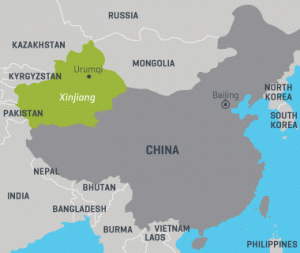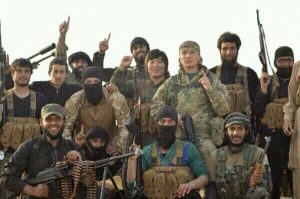Brian M Downing
Few people had heard of the Tuareg before the wars in Libya and Mali. The Kurds were better known but the fighting in Iraq and Syria brought them to prominence. The Uighurs, a Muslim Turkic people, will make themselves better known in coming decades. Chinese policies and Islamist dynamics will see to that.
There are at least ten million Uighurs in China, mostly in the western province of Xianjing. Millions of others live in pockets across Central Asia stretching into Turkey. As the ethnic Chinese population in Xianjing grows, the Uighurs are being marginalized. Sporadic acts of terrorism already occur in many parts of China.
Chinese repression and global trends in militarism suggest the Uighurs can build disciplined terrorist groups and also a large-scale insurgency. They may also play an important role in destabilizing large parts of Central Asia.
China and the Uighurs
The Uighurs of China live mainly in the relatively undeveloped southern parts of Xianjing. A more prosperous Han region lies to the north. Uighurs resent the growing numbers of Han Chinese in their territory but emigrate north for better opportunities. Ethnic conflict takes the form of Uighur demonstrations and occasional terrorist attacks, including bombings and knife attacks. Uighur attacks have also taken place well outside Xianjing in coastal cities.
With haughty confidence in its beliefs and institutions, the Chinese have eschewed counterinsurgency policies or the granting of meaningful autonomy. Beijing’s response has been firmer repression. Beards of “abnormal” length and full veils were prohibited earlier this year. Uighur children are required to attend government schools where, in Beijing’s tendentious estimation, they will be properly acculturated to official outlooks.
The idea of the Uighurs as a people with distinct beliefs and traditions wasn’t terribly strong a half century ago. But a Uighur identity is coalescing and strengthening, just as a Palestinian one has since 1967. Historically the Uighurs have not been especially religious but they are increasingly pious and attracted to militant Islam.
Greater conflict is coming. It can take three forms.
Terrorism
Uighur terrorism today is crude and ineffectual. In 2013 three Uighurs crashed a bomb-laden vehicle into a crowd near Beijing’s Tiananmen Square, killing themselves and two bystanders. Uighurs armed with nothing more sophisticated than knives have gone on rampages in several parts of China.
Many Uighurs have exfiltrated from Xinjiang and joined Islamist militants as far west as the Levant. Hundreds or even thousands are with ISIL in Iraq and Syria. Others operate in eastern Afghanistan alongside al Qaeda and ISIL-Khorasan Province. Still others are with smaller and presently less well-known groups in Kyrgyzstan and Uzbekistan.
Their weaponry is more sophisticated than crude car bombs and kitchen knives. The commitment to Islamism, while under fire alongside fervent Salafist fighters, is likely annealing.
Insurgency
Along with more sophisticated weaponry and proximity to established militant groups comes better organization. ISIL and al Qaeda have leadership, logistics, financial support from many countries, and knowledge of military tactics. Uighurs who are able to infiltrate back into Xianjing will work with those who stayed behind to build a substantive insurgency.
 Fighters will find safe havens in mountainous areas of Xianjing and across the border in Kyrgyzstan and Tajikistan. The reach of governmenst there is highly limited and Islamist ferment has been underway for many years. This is especially so in the Fergana Valley where young men have been joining the Taliban and kindred groups in eastern Afghanistan.
Fighters will find safe havens in mountainous areas of Xianjing and across the border in Kyrgyzstan and Tajikistan. The reach of governmenst there is highly limited and Islamist ferment has been underway for many years. This is especially so in the Fergana Valley where young men have been joining the Taliban and kindred groups in eastern Afghanistan.
Insurgencies require foreign support. They require funds to purchase arms and pay the burgeoning ranks of fighters as the movement grows from a handful of guerrillas to a potent force with battalions of troops, logistical hubs, training bases, and rival governmental structures. The Viet Cong had China and Russia. The Taliban have Pakistan.
India and Vietnam are increasingly wary of Chinese power and could one day see the Uighurs as allies, especially if they are more attuned to insurgency than to terrorism. Partners in East Asia and elsewhere are also possible under certain geopolitical circumstances.
Destabilization of Central Asia
The Uighurs may contribute to further deterioration of political stability in the expanses of Central Asia west of Xianjing. Uzbekistan, Tajikistan, and Kyrgyzstan have weak, corrupt, unpopular governments, large youth cohorts facing bleak prospects, and rumblings of Islamist militancy.
Chinese repression in Xianjing will become very harsh. This may lead to Uighur militants opting to fight their battles in Central Asia, where government repression will be far less effective than that exerted by the People’s Liberation Army. The Uighurs will find kinsmen there as well as like-minded young people of other ethnicities.
 ISIL will lose its capitals of Raqqa and Mosul in coming months. Leaders and fighters will search for new lands to renew the campaign for the caliphate. ISIL caused Arab states to falter. Their armies melted away. Governments were only able to survive because of outside intervention. ISIL must look for a new lands far from the long and powerful reach of American and NATO military forces. The mountains and steppes of Central Asia will beckon, as will the Uighur movement.
ISIL will lose its capitals of Raqqa and Mosul in coming months. Leaders and fighters will search for new lands to renew the campaign for the caliphate. ISIL caused Arab states to falter. Their armies melted away. Governments were only able to survive because of outside intervention. ISIL must look for a new lands far from the long and powerful reach of American and NATO military forces. The mountains and steppes of Central Asia will beckon, as will the Uighur movement.
Copyright 2017 Brian M Downing
Brian M Downing is a national security analyst who has written for outlets across the political spectrum. He studied at Georgetown University and the University of Chicago, and did post-graduate work at Harvard’s Center for International Affairs. Thanks to Susan Ganosellis!